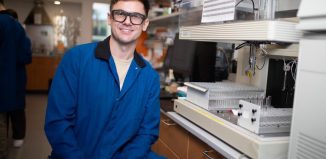CSHL’s Zachary Lippman creates tomato tool kit
Imagine a pizza restaurant. Every day, the chef cooks a certain number of pies. At a specific point, the kitchen reaches a maximum. What if that restaurant could double its production?
That’s what Zachary Lippman, an associate professor at Cold Spring Harbor Laboratory, and colleagues in Israel did, except that instead of doubling his pizzas, he doubled the amount of fruit his tomato plants produced.
Lippman used the same kind of mutations that agriculturalists have employed for centuries to increase crop yields.
“The approach we took was to find new mutations and design specific screens” that would favor flowering instead of bushiness, Lippman said.
Lippman and collaborators from Israel created a tool kit of genes that balance between the hormones florigen and anti-florigen. The first one, florigen, promotes flowering and flower and fruit production. The second one, anti-florigen, promotes shoot and leaf production.
Florigen and anti-florigen are “like this yin and yang,” Lippman said. “We found mutations in genes that affect the florigen/anti-florigen paradigm.”
By cross breeding these mutations, Lippman and his associates were able to pinpoint what he described as “an optimal architecture,” which originates from an optimal balance of flowering signals, he said.
This genetic tool kit could have applications to other agricultural crops, such as soybeans, which, Lippman explained, share many growth similarities to tomatoes.
With the world population expected to reach 9 billion by the middle of this century, these kinds of discoveries could prove important in increasing food production, Lippman said. He is thinking of testing this tool kit in cowpea, a major crop related to soybean that is grown in Africa.
“The major advance in the present work is the illustration that fine tuning of signals from these hormones can help improve tomato field performance and thus, similar, directed changes can be applied in other plants,” explained Yuval Eshed a professor in the Department of Plant and Environmental Sciences at the Weizmann Institute of Science in Israel who collaborated with Lippman on this study. Eshed has worked with Lippman for almost a decade and called his partner “an outstanding scientist” who is “original, thorough and trustable.”
The approach Lippman and his team took does not involve inserting DNA into the plant but rather comes from the development of mutations, Lippman said.
“It’s the standard idea of classic genetic modification,” Lippman said. “We were able to design a way to find and select for mutations much faster than what Mother Nature has given us by using what people have been doing for decades.”
The genetic tool kit, with several specific mutations, gives scientists and, potentially, tomato producers a chance to boost the production without compromising the plant or the taste of the tomato.
At the same time there is no difference in the fruit quality or the plant, he said. “Sugar is unaffected,” he offered.
To be sure, like some animals bred in a zoo or plants farmers have used for hundreds or even thousands of years, these new tomato plants, with their collection of mutations designed to increase yield, would not fair as well outside of the confines of a farm. “What’s optimal in nature is not what’s optimal in agriculture,” Lippman explained. “We’re selecting for growing in greenhouses or fields.”
Lippman used this tool kit in cherry, plum and beefsteak tomatoes. He is hoping to test all major varieties of tomato, including slicing tomatoes for burgers, grape tomatoes and cocktails. This approach should work across the types of tomatoes, but he hasn’t conducted those tests yet. He has had some contact from companies that grow tomatoes and will likely enter a collaboration soon.
Lippman said introducing these new mutations into the elite breeding lines of tomato farmers may create some complications. “We don’t know how those mutations will respond” in the designer tomatoes agricultural companies use, he said. “One combination might work in one variety, whereas another combination might work in another variety.” The tool kit, however, provides a genetic resource.
“This summer, we repeated the experiment for a fourth time,” he said. He organized these plants in a row according to their mutations. “If you walk down the row, you could see the progressive quantitative increase,” with the plants going from bushy to less bushy to almost a tree. To see the yield [change] was even more impressive.”
Lippman, who has been working for for six years at CSHL, said these results are “by far the most important work to come out of my lab. This is the most fun” he’s had conducting research.






